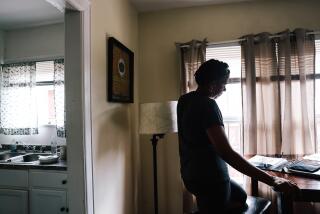Typhoid Mary case may be cracked, a century later
When Typhoid Mary died in 1938, in medical exile on a tiny New York island, she took untold numbers of Salmonella typhi to her grave. No one knew how the bacteria managed to thrive and not kill her.
A team of microbiologists from Stanford University and UC San Francisco has found a tantalizing clue: a bacterium strain similar to the one responsible for “healthy” carriers such as Typhoid Mary shows an ability to hack the metabolism of the cells sent out to defend from infection and heal trauma.
“Salmonella is adapted to infect mammalian hosts; in fact, salmonella typhi only infects humans,” said Stanford microbiologist Denise Monack, lead author of the study published online Wednesday in the journal Cell Host and Microbe. “So it’s very interesting for me to try to understand why that is.”
The trickery, revealed in experiments with mice, involves a receptor protein that affects how macrophages -- the body’s Pac-Man gobblers of foreign pathogens -- get the energy required to survive. The team found that the bacteria tend to hang out with a mellower macrophage associated with the later stages of infection. Enough of the bacteria survive the more aggressive wave of attackers during the inflammatory phase of the immune response to settle in with the more placid anti-inflammatory cells, according to the study. Once inside, the bacteria essentially hack the genetic programming that sets off production of glucose for the host cell, and its own survival.
Mice infected with the salmonella strain typhimurium, known to cause symptoms of typhoid fever in rodents, showed increased activity of a protein known as peroxisome proliferator-activated receptors, or PPAR-gamma, the study found.
The protein “controls the metabolic pathways in the macrophage and it allows the macrophage to bring in fatty acids to utilize them as a carbon source, for energy,” Monack said.
Mice whose genes were altered to be deficient in production of the transcriptional protein were a lot like Typhoid Mary -- infected, but not sick. Six weeks later, levels of the tell-tale protein were nearly undetectable.
The revelations offer a hint at developing therapies that could potentially block the activity of the bacteria, Monack said.
Although typhoid fever is not the widespread killer it once was, the mechanisms of microbes that cause it offer critical insights into human pathology. Salmonella typhi also remains enough of an evolutionary puzzle to preoccupy Monack for some 25 years.
“There aren’t a ton of pathogens that hang out in macrophages,” Monack said. The bacterium that causes tuberculosis is another, she noted.
Salmonella typhi is a young microbe by evolutionary standards, tracing back some 50,000 years. In that time, it has adapted and triumphed over competitors to dominate a remarkably narrow niche: human immune systems.
Evolutionary biologists believe invasion and genetic hijacking were how the earliest animal and plant cells acquired mitochondria -- the ubiquitous energy-generating organelle that is suspiciously similar to bacteria.
These days, typhoid fever strikes about 16 million people worldwide, killing about 600,000, predominantly in non-industrialized nations, according to the World Health Organization. About 75% of the 5,700 U.S. residents sickened annually by the bacterium contracted it after traveling to other countries, according to the Centers for Disease Control and Prevention. The illness can be prevented by vaccine and is treatable with antibiotics, although it is showing signs of developing resistance to multiple drugs, in a manner similar to the staphylococus bacterium.
But Americans largely view the disease through the story of Mary Mallon, the Irish immigrant cook who spread the bacterium throughout New York in the first decade of the 20th century. The earliest cases struck a family in Oyster Bay, Long Island, a popular site for estates and vacation homes for the well-heeled Manhattan elite. A Manhattan outbreak soon followed.
The germ theory of disease had been established for decades, and Louis Pasteur had pioneered the first rabies vaccination, but penicillin’s discovery was still decades away, and the gaps in understanding pathogens were enormous.
Medical professionals did not crack the case: that was left to George Soper, a sanitation engineer from Manhattan who had visited Ithaca, N.Y., during a raging typhoid outbreak in 1903, and had read of the work of microbiological pioneer Robert Koch, who had investigated typhoid fever outbreaks in Germany. Until Soper focused on Mallon as the common element in all the new outbreaks, no “healthy” carrier of typhus had ever been identified in the U.S.
Quickly dubbed Typhoid Mary in medical journals and the popular press, Mallon became infamous. Viewing the epidemiology campaign as persecution, Mallon had to be persuaded to cooperate with authorities. She eventually was quarantined to Riverside Hospital on North Brother Island, off the Bronx shores, from 1907-1910.
After her release, Mallon worked at a laundry, but eventually adopted an alias and returned to more lucrative domestic work, including cooking, in 1915. She was working as a cook at Manhattan’s Sloane Maternity Hospital in 1915 when typhoid fever again broke out, and authorities tracked her down and arrested her, sending her back to North Brother Island, where she died in 1938.
About 3,500 cases of typhoid fever were reported in the 1909 outbreak. How many could be traced to Mary Mallon is unknown, although reasonable estimates of deaths directly tied to her hover around 50. The first large-scale vaccination program began in 1909, in the U.S. Army, but it would be decades before widespread vaccination and improvement in food and water sanitation would push the disease into an obscure niche in the United States.
Riverside Hospital was closed shortly after Mallon’s death. Its ruins remain visible on the island, now a designated bird sanctuary.
[For the Record, 4:05 p.m. PDT Aug. 14: An earlier version of this online post said that microbial pioneer Robert Koch had investigated typhus outbreaks in Germany. He investigated typhoid fever outbreaks. Also, the earlier version mentioned deadly outbreaks of typhoid fever in Athens, the Jamestown, Va., colony and among Napoleon’s troops in Russia. Those outbreaks actually were due to typhus.]







